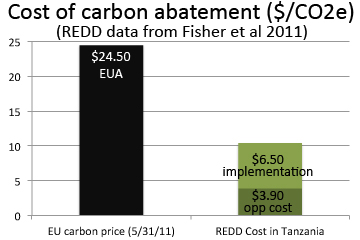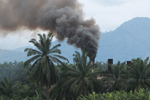Implementation costs of REDD are higher in Tanzania than commonly acknowledged.
Efforts to reduce greenhouse gas emissions from deforestation and forest degradation (REDD) must incorporate the implementation cost of programs to meet resource demands of local people in order to be successful, argues a new study published in Nature Climate Change.
The research, led by Brendan Fisher of Princeton University, looked at deforestation in the Eastern Arc Mountains of Tanzania. It found that current economic assessments tend to undervalue the cost of meeting expected food and fuel demand by local farmers, who would be expected to curtail forest conversion under the country’s REDD program. Failing to meet the needs of local farmers, could either increase poverty or displace forest conversion to forests outside the reach of REDD programs, an issue known as “leakage”.
 |
The authors therefore argue for Smart-REDD, the idea that REDD projects incorporate the implementation cost of implementing programs like boosting agricultural yields to reduce pressure on forest lands and subsidizing efficient cookstoves to cut fuelwood use.
In Tanzania, the researchers estimate the cost of implementing such programs at $6.50 per ton of carbon dioxide emissions avoided (tCO2), well above the $3.90/tCO2 cost of merely compensating for the profits forgone by stopping deforestation.
The authors’ conclusions are consistent with other work that has shown implementation and transaction costs can be considerable relative to the opportunity costs of REDD projects, especially those involving small farmers. Opportunity costs are comparatively higher for industrial-scale activities like logging, soy farms, oil palm estates, and rubber and wood-pulp plantations, since these generating more profit per unit of area.
CITATION: Brendan Fisher,
Simon L. Lewis,
Neil D. Burgess,
Rogers E. Malimbwi,
Panteleo K. Munishi,
Ruth D. Swetnam,
R. Kerry Turner,
Simon Willcock
& Andrew Balmford (2011). Implementation and opportunity costs of reducing deforestation and forest degradation in Tanzania. Nature Climate Change (2011) doi:10.1038/nclimate1119 Published online
29 May 2011
Related articles
(05/14/2011) Presentation by Rhett A. Butler at the Smithsonian Tropical Research Institute in April 2011 on the Costs of REDD+.
(05/14/2011) The co-founder of an initiative that discourages illegal logging by bringing affordable, high quality health care to impoverished communities in Indonesian Borneo has been recognized with a prestigious conservation award.
Study calls for REDD+ money to boost yields in West Africa using agrochemicals
(04/10/2011) Small-scale agriculture including cocoa, cassava, and oil palm farming has driven large-scale conversion West Africa tropical forests, reports new research published in the journal Environmental Management.
To succeed, REDD should consider factors outside forest sector
(01/24/2011) Policymakers should not ignore activities outside the forestry sector in efforts to reduce global deforestation, argues a new report published by the International Union of Forest Research Organizations (IUFRO).
Will Indonesia’s big REDD rainforest deal work?

(12/28/2010) Flying in a plane over the Indonesian half of the island of New Guinea, rainforest stretches like a sea of green, broken only by rugged mountain ranges and winding rivers. The broccoli-like canopy shows little sign of human influence. But as you near Jayapura, the provincial capital of Papua, the tree cover becomes patchier—a sign of logging—and red scars from mining appear before giving way to the monotonous dark green of oil palm plantations and finally grasslands and urban areas. The scene is not unique to Indonesian New Guinea; it has been repeated across the world’s largest archipelago for decades, partly a consequence of agricultural expansion by small farmers, but increasingly a product of extractive industries, especially the logging, plantation, and mining sectors. Papua, in fact, is Indonesia’s last frontier and therefore represents two diverging options for the country’s development path: continued deforestation and degradation of forests under a business-as-usual approach or a shift toward a fundamentally different and unproven model based on greater transparency and careful stewardship of its forest resources.
Congo biochar initiative will reduce poverty, protect forests, slow climate change

(05/19/2009) An initiative using soil carbon enrichment techniques to boost agricultural yields, alleviate poverty, and protect endangered forests in Central Africa was today selected as one of six projects to win funding under the Congo Basin Forest Fund (CBFF). The scientific committee of the CBFF awarded Belgium’s Biochar Fund and its Congolese partner ADAPEL €300,000 to implement its biochar concept in 10 villages in the Equateur Province of the Democratic Republic of Congo. The approach improves the fertility of soils through the introduction of “biochar” — charcoal produced from the burning of agricultural residues and waste biomass under reduced oxygen conditions — thereby increasing crop yields and reducing the need to clear forest for slash-and-burn agriculture.
Africa calls for “full-range” of bio-carbon as climate solution
(12/10/2008) A coalition of 26 African countries is calling for the inclusion of carbon credits generated through afforestation, reforestation, agroforestry, reduced soil tillage, and sustainable agricultural practices in future climate agreements.